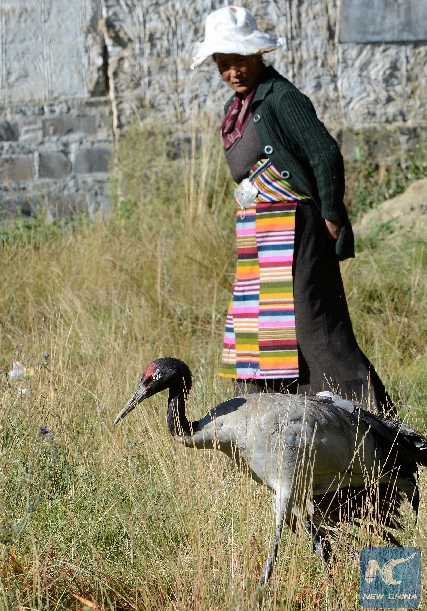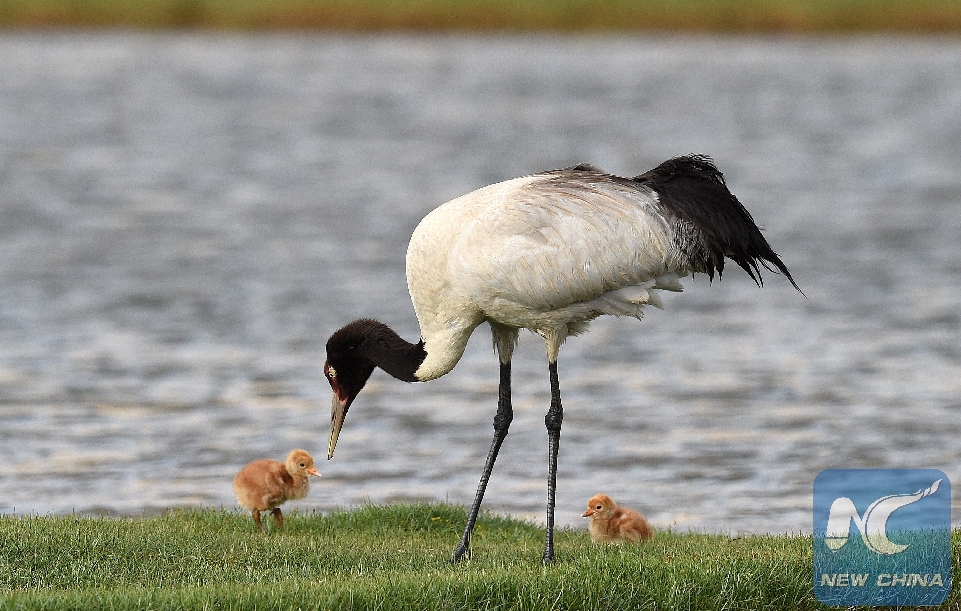
Aerial photo taken on March 10, 2018 shows a black-necked crane in Linzhou County, southwest China's Tibet Autonomous Region. (Xinhua/Purbu Zhaxi)
The population of a critically endangered crane has continued to increase in southwest China's Tibet Autonomous Region thanks to enhanced conservation efforts in recent years, an environmental protection official said Tuesday.
Tibet currently has more than 8,000 black-necked cranes, at least 80 percent of the world's total, said Jampel, deputy chief of the regional environment protection administration.
He said the figure represented a significant increase from 6,900 reported in 2007, and 3,900 in 1992.

Black-necked cranes are seen in the Linzhou County, southwest China's Tibet Autonomous Region, Jan. 9, 2015. (Xinhua/Purbu Zhaxi)
Black-necked cranes are native to the plateau regions of China, India, Bhutan and Nepal. They are among some 90 endangered species on China's top protection list, along with the giant panda and golden monkey.
The species is on the International Union for Conservation of Nature (IUCN) red list of threatened species, with less than 10,000 in the world.

Black-necked cranes are seen in a reservoir where they spend the winter season in Linzhou County of Lhasa City, capital of southwest China's Tibet Autonomous Region, in January of 2017. (Xinhua/Liu Dongjun)
Black-necked cranes are often seen in Tibet's river valleys and in the region's barley and wheat fields in winter. They migrate to northern Tibet between mid March and late April to reproduce in the lakeside marshes.
Tibet has set up several nature reserves to protect the rare birds in recent decades, said Jampel.
The nature reserves in the Yarlung Zangbo River valley, Serling Tso Lake, Lhalu wetland in the suburbs of Lhasa and in Lhundrup and Shantsa counties are all major habitats for black-necked cranes, he said.
Besides the rare birds, Jampel said Tibet has reported progress in its protection of 125 other endangered wild animal species and 39 wild plants.

A black-necked crane, once wounded during migration, becomes a permanent resident at a temple near Xigaze, southwest China's Tibet Autonomous Region, Sept. 27, 2014. (Xinhua/Chogo)
Tibet has 47 nature reserves, eight national forest parks, three wetland parks and four geological parks to help preserve the region's biodiversity.
Last year alone, Tibet set up three new nature reserves and spent 20.7 million yuan (3.2 million U.S. dollars) to improve the rural environment in 26 villages.

A black-necked crane looks after its chicks in the Qiangtang nature reserve, southwest China's Tibet Autonomous Region, in June of 2017. Black-necked cranes are often seen in Tibet's river valleys and the region's barley and wheat fields in winter. (Xinhua/Chogo)
Meanwhile, the region spent a total of 780 million yuan to preserve its natural forests, wetlands and wildlife, prevent forest fires, plant diseases and insect pests and promote clean energy in nomadic communities, according to the regional government.
Experts say environment protection on the Tibet Plateau is essential in fighting glacial melting and climate change.

